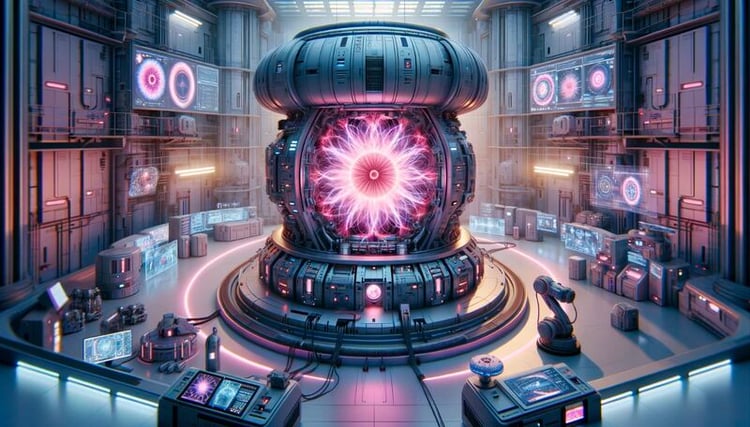Partners in Power: Artificial Intelligence and Fusion Energy

At the recent World Economic Forum (WEF), Sam Altman reported that Artificial Intelligence (AI) is using a growing percentage of the world's energy and that fusion energy could be the solution to meet this new demand. In Sam’s own words, "There's no way to get there without a breakthrough. It motivates us to invest more in fusion." Altman went on to say that he wishes the world would embrace nuclear fission as an energy source as well.
Some of the world’s wealthiest and most influential technology leaders, including Jeff Bezos, Bill Gates, Marc Benioff, and Sam Altman, have already invested in fusion energy. In 2021, Altman invested around $375 million in a nuclear fusion company called Helion Energy. Conveniently, the company has since signed a partnership with Microsoft, the tech giant that invested $13 billion in OpenAI.
Leading the Charge: AI Joins Fusion Energy
Altman has also suggested that AI could crack the case for making fusion a practical energy technology. Fusion energy, the process that powers the stars, could become the ultimate power source for humanity. This clean and almost limitless energy source offers a tantalizing glimpse into a future free from the shackles of fossil fuels and the volatility of renewable energy sources. However, the road to harnessing fusion energy is complex, and it is here that AI becomes an indispensable ally for predictive analytics, monitoring, and scaling efficiency.
AI Drives Power Consumption
A basic request to any AI platform alongside a fleet of NVIDIA GPUs activates memory and storage systems, leading to increased power consumption. A few keystrokes by each of us can have a material impact on our power grids. “The energy consumption of something like ChatGPT inquiry compared to some inquiry on your email, for example, is going to be probably ten to 100 times more power hungry," Professor of Electrical and Computer Engineering Sajjad Moazeni told Yahoo Finance last year. This change in how we search and create content will drive growth in power consumption as we enter a time of questionable power grid stability. This is one of the many reasons that fusion energy is considered critical for our planet's clean energy future and the future of AI.
AI Drives Fusion Energy
While AI is revolutionizing almost every industry, from retail to programming to healthcare to finance, Fusion Energy is also leveraging AI to help make its processes more scalable and commercially viable. NVIDIA, a leader in AI, reported record-breaking quarters in 2024, emphasizing AI’s profitability and growth. One of the key growth areas for AI lies in applications like fusion energy, which can potentially reshape our world. AI algorithms can monitor and adjust the magnetic fields in tokamaks – the most advanced fusion energy reactors – to maintain the stability of the plasma, a core requirement for sustaining fusion reactions. Moreover, AI can quickly process the data from each test fusion reaction – something that would take humans significantly longer – to refine the next attempt, bringing us closer to a viable fusion process.
NanoPlex - Fusions Provider of Pulsed Power
At the heart of powering fusion energy and AI is the next generation of high-energy and high-temperature NanoPlex-based capacitors. In simple terms, magnetic and laser-based fusion reactors need strong pulses of power provided by next-generation capacitors to drive towards commercial viability for efficiency and provide cost-effective clean energy on a 24/7 basis. Reaching the mass market for fusion energy requires reactors to be cost-effective, with lower operating costs, and deliver a stable and predictable energy source to become a viable replacement for the current power plants. At Peak, we see four ways NanoPlex-based capacitors can accelerate the growth and viability of AI and Fusion:
-
Improving Fusion Power Generation: NanoPlex-based capacitors will enable fusion power plants to improve their power generation efficiency ratio (power required to generate fusion vs. the power multiple produced for consumption), which drives/lowers the cost per kilojoule.
-
Stronger Power Bursts: NanoPlex-based capacitors can store up to 2-4x more power than industry standard Biaxially Oriented Polypropylene (BOPP) capacitors, enabling fusion reactors to be more efficient.
-
Optimize Reactor Up-Time: NanoPlex-based capacitors will have up to 4-6x longer lifetimes than BOPP capacitors based on improved temperature ratings.
-
Lower Operational Cost: NanoPlex-based capacitors will lower the cost of operating and maintaining fusion power plants, increasing power generation, improving uptime, and reducing the power plant’s footprint to house pulsed power capacitors.
Fusion Energy is a Team Sport
To enable a cleaner energy future, Peak is working with policymakers, government agencies, industry partners, and the Fusion Industry Association to build a U.S.-based supply chain for critical fusion technology and manufacturing. No single company or government agency is capable of creating a viable commercial solution, so this will require the collaboration of several teams. Investments in AI and fusion by the wealthiest and most intelligent people are a positive indication for the future of both technologies. Peak is proud to contribute to a clean and sustainable future and is looking forward to the advancements in energy and the impact it will make on our planet.

